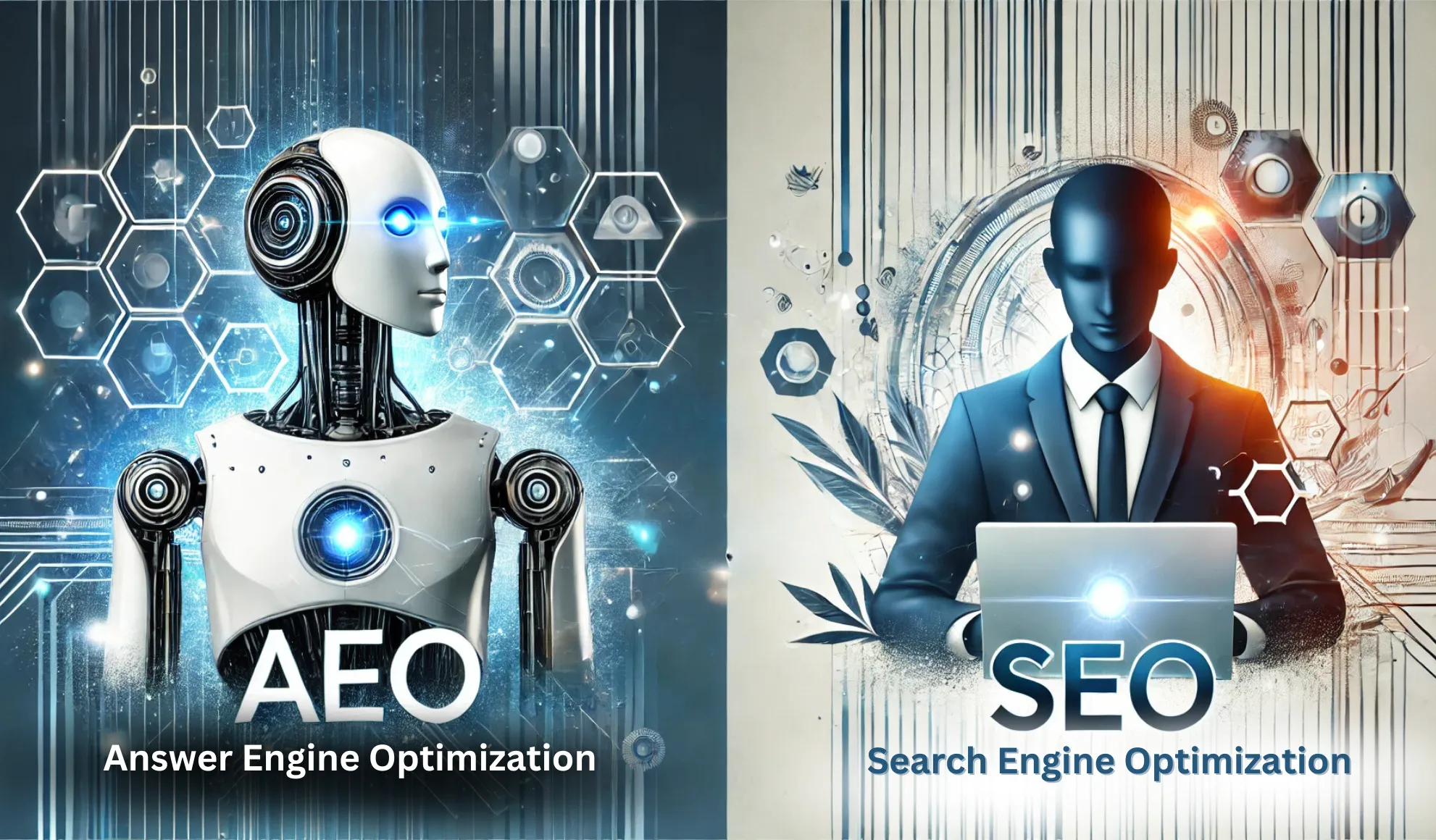It is a little bit like trying to catch a moving target: the digital world. And just when you might feel you’ve got the hang of this SEO-that’s search engine optimization come across something called AEO, or answer engine optimization. Well, now more than ever, knowing the difference between those two approaches, and why each is valuable, can make all the difference in your online strategy.
SEO Essentials: What It Is and How It Works
Let’s go back to the beginning. SEO is the backbone of visibility on the internet for many years. Essentially, it has been about helping your website come up higher in search engine results, all so you have as many visitors as possible going to your site. Generally speaking, this umbrella can be divided into three big categories.
- On-Page SEO: This is what you control on each page of your site, from keywords and headings to meta descriptions. Each of these snippets essentially tells search engines what your page is about, making it easier for them to rank you for relevant queries.
- Off-Page SEO: A great extent of this is link building. The more other respected websites link back to your work, the more search engines can tell that what you’re saying is credible. It’s basically word-of-mouth online.
- Technical SEO: It focuses on the back-end aspects, including site speed and mobile-friendliness that affect the user experience. A smooth site, secure, and fast website increases its chances to get ranked.
While SEO is all about driving traffic, the latest online behaviors—like people asking direct questions to devices—have brought a new contender to the stage: AEO.
What is AEO (Answer Engine Optimization)?
AEO, or Answer Engine Optimization, is relatively new but gaining traction fast. It’s providing users with quick answers to direct their query usually right on the search results page without having to click a link. With all the voice searches that are emerging, people expect an answer right away, and AEO meets that need just right.
A few places you’ve likely seen AEO in action:
- Featured Snippets: These are those little boxes at the top of Google with an answer pulled straight from a website. They’re designed to give quick answers to common questions.
- People Also Ask: Google often shows related questions, with drop-downs that provide quick answers directly on the search page.
- Knowledge Graphs: Google uses these to give users instant information about people, places, and things based on data from trusted sources.
The beauty of AEO lies instead in knowing what users want and writing in such a way that clearly and concisely answers questions. That’s especially helpful on voice searches, which usually have users who are either asking conversational-type questions or who expect straight answers.
AEO vs. SEO: The Main Differences
Though SEO and AEO work toward similar goals—visibility and user engagement—the way they achieve these results is different.
- Goal and Approach: SEO aims to bring users to your website by ranking higher on SERPs. AEO, meanwhile, is more focused on answering user queries directly on the search page.
- Focus on User Intent: While SEO includes keywords that attract clicks, AEO goes a step further by trying to understand exactly what the user wants to know.
- Content Style: SEO tends to focus on longer, keyword-rich content, while AEO works best with short, structured answers that directly address common questions.
- Technical Optimization: Both rely on backend elements like schema markup, but AEO places a strong emphasis on structured data so search engines can display answers directly.
- How Success Is Measured: With SEO, it’s about page rankings and traffic. AEO, on the other hand, focuses on things like snippet appearances and engagement with those on-page answers.
In today’s world, it’s not about picking one or the other. A balanced strategy that considers both can open up more avenues to connect with your audience.
Why AEO is Gaining Popularity
AEO is really taking off, especially more with people using voice-activated devices like Google Assistant, Alexa, and Siri. It encourages users to ask a question in a natural way and very often expect an immediate answer that can benefit businesses a lot.
Let’s say you’re a local service provider. People may be searching “best plumber near me” or “quick fix for a leaky pipe, hoping to get the quickest, simplest answers. With your content optimized for AEO, you will most likely show up at the very top in a snippet, helping the user right from the search page without ever requiring them to click through.
But industries that focus on real-time information—health, home service, retail, and more—would obviously be well-suited for AEO strategies. As mobile and voice searches grow in usage, businesses in virtually every industry might do well to consider optimizing for AEO, too, if they’re not already.
How SEO and AEO Work Together
Contrary to popular belief, SEO and AEO aren’t opposing forces. They can, in fact, complement each other beautifully. Here’s how a balanced strategy can deliver great results:
- Greater Visibility: By targeting both SEO and AEO, you cover all bases, attracting users who are looking for in-depth content and those seeking quick answers.
- Enhanced User Experience: By structuring content for both detailed SEO and quick AEO-style responses, you make it easier for users to find what they need.
- Content Versatility: FAQ pages, product guides, and even blog posts can rank well for both SEO and AEO, giving you more opportunities to reach users on different fronts.
For example, adding an FAQ section to a blog post not only helps with SEO but can also increase your chances of appearing in a featured snippet or “People Also Ask” section.
Optimizing Content for Both SEO and AEO
Now, let’s talk about how to make sure your content is optimized for both. Here are some tips:
- Keyword Research: Include traditional keywords for SEO while also using question-based keywords to target AEO. Think about the way people phrase their queries in conversational searches.
- Structured Data: Use schema markup to help search engines understand your content. FAQ and HowTo schema work especially well for optimizing for AEO.
- Snippet-Friendly Formatting: Structure your content to answer questions clearly and concisely. Use bullet points, short paragraphs, and direct answers to increase your chances of appearing in featured snippets.
- Conversational Tone: Especially for AEO, write in a conversational style. Users searching by voice tend to use natural, casual phrasing, so the more your content mirrors that tone, the better.
By optimizing for both SEO and AEO, you give your site the best possible chance to reach users, whether they’re looking for a quick answer or in-depth information.
AEO vs. SEO: Which Should You Prioritize?
Should you focus more on SEO or AEO? The answer depends on your goals and industry.
For instance:
- SEO is ideal for businesses looking to drive high traffic to their sites, especially in industries that rely on comprehensive, long-form content to build brand awareness.
- AEO works well for industries with lots of voice searches or businesses that benefit from instant, answer-based interactions.
At the end of the day, the most effective strategy uses both. Combining the strengths of AEO and SEO allows you to cover all bases, enhancing your site’s visibility and usefulness to users at every stage of their search journey.

Final Thoughts
The world of search is changing fast, and it pays to be adaptable. For businesses, integrating both SEO and AEO into a digital strategy can mean better visibility, higher engagement, and more opportunities to connect with users. Whether working with the best SEO company in the USA or developing an in-house strategy, leveraging these approaches together can be a powerful way to future-proof your digital presence. By meeting both traditional SEO needs and newer AEO expectations, you create a comprehensive approach that appeals to all types of searchers, ensuring your business stays relevant in a rapidly evolving online landscape.
FAQ’s
1. How to increase search engine optimization?
To increase your search engine optimization (SEO), focus on key strategies like keyword research, high-quality content, and improving user experience. Start by identifying relevant keywords that your audience frequently searches. Then, create valuable, informative content around those keywords to match user intent. Optimizing technical aspects—such as site speed, mobile-friendliness, and a clear URL structure—helps search engines crawl and rank your site effectively.
2. Why is AEO important for my business?
AEO is also one of the most important strategies for businesses aiming to attract visibility in the fast-changing, voice-driven landscape of search. While business users look for quick, direct answers, AEO puts the user’s content in front of featured snippets and voice search results so that the potential customers find the right solution even if they do not visit your site. By using AEO strategies, businesses are capable of building recognition and establishing authority in real-time.
3. What is organic search engine optimization?
It is, in simple words, the techniques used for improving the ranking of a website in unpaid (or “organic”) search results. Organic SEO refers to optimizing various aspects of your site—like keywords, content quality, and technical elements. Unlike paid ads, organic SEO delivers long-term, sustainable traffic growth by aligning with search engine guidelines and meeting user intent, making it a more trustworthy online presence.
4. How much does search engine optimization cost?
Price ranges for SEO vary widely, depending on everything from the scope of services to the competitiveness of your industry and the level of expertise your chosen agency or professional has. For instance, basic support might only cost a small business $500 to $2,000 a month, but large businesses or very competitive niches may spend upwards of $5,000 or more a month for SEO services. One-time projects can cost anywhere from $1,000 to $30,000.
5. What types of content are best suited for AEO?
AEO content should be clear and direct, answering specific questions. FAQs, step-by-step guides, lists, and short summaries are excellent because the search engines will easily retrieve whatever they need to create featured snippets and voice results. This is also AEO-friendly in that such content is easier to format with headers, bullet points, and step-by-step formats.





